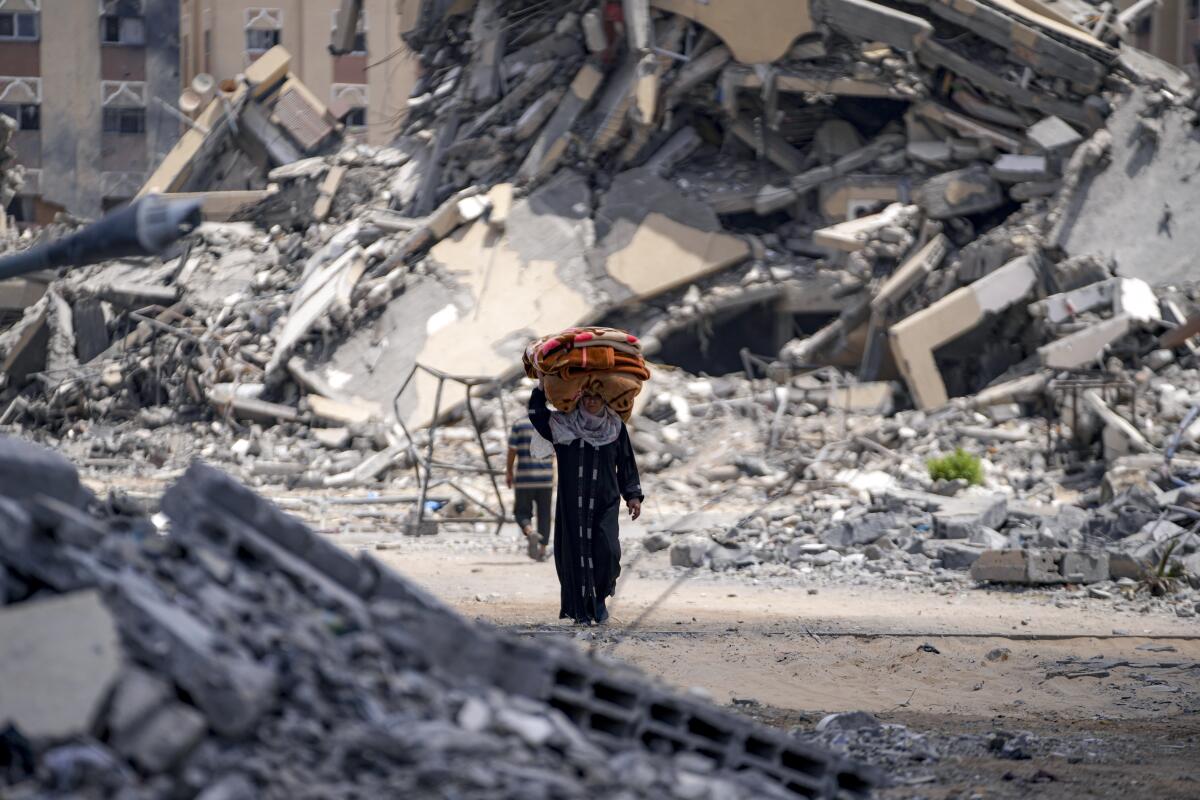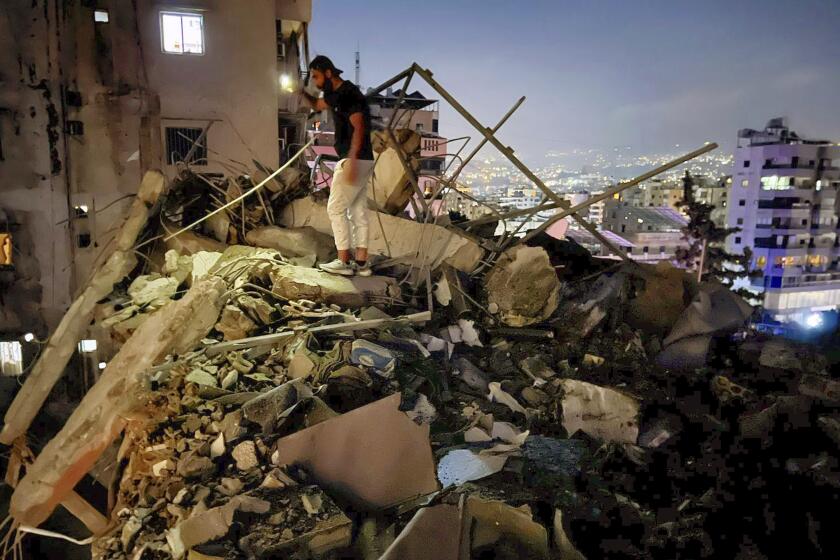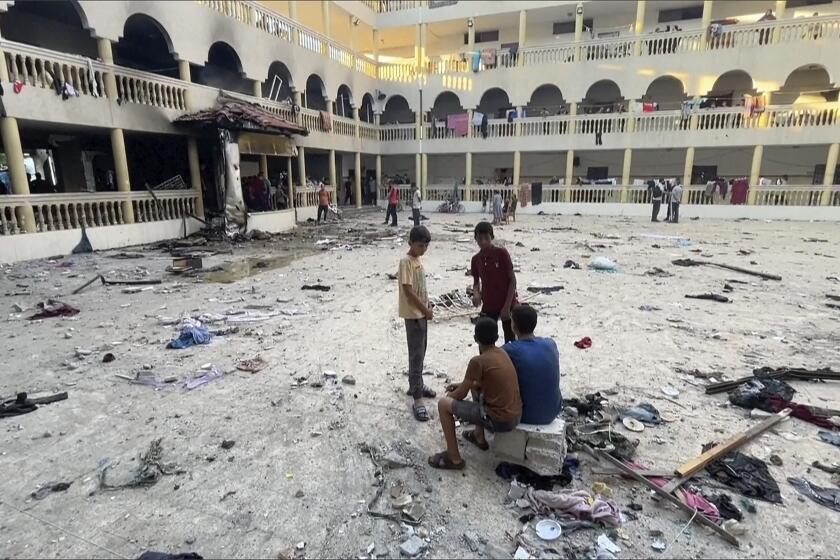U.S. beefs up posture in Middle East, warns an Iran-backed attack on Israel could come this week

- Share via
WASHINGTON — The U.S. continues to beef up its military presence in the Middle East while Western leaders warn Iran to “stand down” its threats of an attack on Israel.
U.S. Defense Secretary Lloyd J. Austin III has ordered a guided-missile submarine to the Middle East and is telling the USS Abraham Lincoln aircraft carrier strike group to sail more quickly to the area. The U.S. on Monday said it believes Iran or its proxies may launch a strike against Israel as soon as this week.

The moves, announced by the Defense Department on Sunday, come as the U.S. and other allies push for Israel and the militant group Hamas to achieve a cease-fire agreement that could help calm soaring tensions in the region after the assassination of Hamas political leader Ismail Haniyeh in Tehran and a senior Hezbollah commander in Beirut.
Officials have been on the lookout for retaliatory strikes by both Iran and Hezbollah for the killings.
John F. Kirby, the White House national security spokesman, said Iran’s response to the killings “could be this week,” but that “it is difficult to ascertain at this particular time if there’s an attack by Iran or its proxies what it could look like.” He said the U.S. and its allies were preparing for a “significant set of attacks.”
Hamas leader Ismail Haniyeh was assassinated in Iran after attending the inauguration of the country’s new president, Iran and the militant group said early Wednesday. Hamas blamed an Israeli airstrike.
“The president is confident that we have the capability available to us to help defend Israel should it come to that,” Kirby said, adding, “Nobody wants to see it come to that.”
Maj. Gen. Pat Ryder, Pentagon press secretary, said in a statement that Austin spoke with Israeli Defense Minister Yoav Gallant earlier in the day, and reiterated America’s commitment “to take every possible step to defend Israel and noted the strengthening of U.S. military force posture and capabilities throughout the Middle East in light of escalating regional tensions.”
A joint statement from the leaders of the United States, Britain, France, Germany and Italy “called on Iran to stand down its ongoing threats of a military attack against Israel and discussed the serious consequences for regional security should such an attack take place.”
Israel launched an airstrike targeting a senior Hezbollah commander it said was responsible for a rocket attack over the weekend.
German Chancellor Olaf Scholz spoke by phone Monday with Iranian President Masoud Pezeshkian and “expressed his great concern about the danger of a regional conflagration in the Middle East,” the German government said.
British Prime Minister Keir Starmer also spoke to Pezeshkian and called on him to refrain from carrying out an attack, the prime minister’s office said.
The Vatican secretary of state, Cardinal Pietro Parolin, spoke with Pezeshkian as well on Monday, “reiterating the need to avoid in any way the widening of the very serious conflict underway,” according to a Vatican statement.
The Lincoln, which has been in the Asia Pacific, had already been ordered to the region to replace the USS Theodore Roosevelt aircraft carrier strike group, which is scheduled to begin heading home from the Middle East. Last week, Austin said the Lincoln would arrive in the Central Command area by the end of the month.
It was unclear Sunday what his latest order means, or how much more quickly the Lincoln will steam to the Middle East. The carrier has F-35 fighter jets aboard, along with the F/A-18 fighter jets that are also on carriers.
An Israeli airstrike hit a school and mosque complex used as a shelter in Gaza City, killing at least 80 people, Palestinian health authorities say.
Ryder also did not say how quickly the USS Georgia guided-missile submarine would get to the region.
He said Austin and Gallant also discussed Israel’s military operations in Gaza and the importance of mitigating civilian harm.
The call came a day after an Israeli airstrike hit a school-turned-shelter in Gaza early Saturday, killing at least 80 people and wounding nearly 50 others, Palestinian health authorities said, in one of the deadliest attacks of the 10-month Israel-Hamas war.
On Monday, the Health Ministry in Gaza said Israeli strikes over the previous 48 hours killed 142 people and wounded 150 others. Those fatalities bring the Palestinian death toll in Gaza to 39,897 since the start of the war, according to the ministry. It says more than 92,000 people have been wounded. The ministry figure does not differentiate between combatants and civilians.
The Health Ministry, part of the Hamas-run government, maintains detailed records and its casualty figures from previous wars have largely matched up with those of independent experts, the United Nations and even Israel’s own figures.
The war began when Hamas launched a surprise attack into southern Israel on Oct. 7. Palestinian militants killed some 1,200 people, mostly civilians, and abducted around 250 others. Of the roughly 110 hostages believed to remain in captivity, Israeli authorities believe around a third are dead.
Baldor writes for the Associated Press. Times staff contributed to this report.
More to Read
Sign up for Essential California
The most important California stories and recommendations in your inbox every morning.
You may occasionally receive promotional content from the Los Angeles Times.













